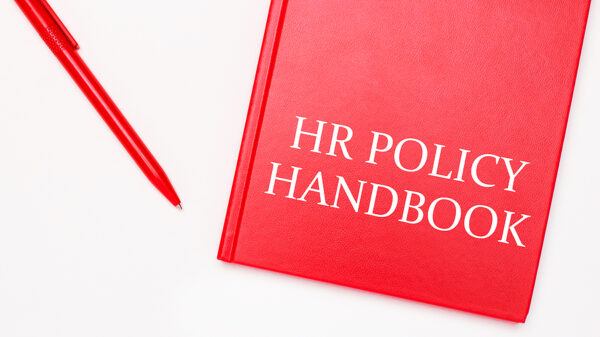As an HR Leader, one of the more important things to consider is per company policy tools. Unfortunately, many HR Leaders are slow to create them, if at all. However, once more focus is put into operations—particularly when scaling up—you’ll soon realize the need for company policies to ensure business continuity and success.

However, Googling for Per Company Policy Tools is not enough. Every company has a different culture, vision, goals, and core values. These things must be reflected in your company policies. They must be crafted in a way that represents what your organization stands for while providing employees with a clear understanding of the company’s culture and mission.
How to Create Company Policies
How do you create a company policy that embodies the organization’s culture and mission statement? Here is a step-by-step guide to get started:
Step #1: Know the Definition of a Company Policy
Company policies are a set of guidelines governing a company’s code of conduct, within and outside the workplace. They apply to both managers and employees to ensure everyone is working on the same page. They are often written policies included in a business’s employee handbook.
To some extent, a policy can serve as legal protection for both parties, as it identifies how all parties must behave, interact, and work. Good company policies promote employee wellness, compliance with laws and regulations, and fair treatment of employees.
Step #2: Identify Types of Per Company Policy Tools
There can be many kinds of company policies in place for one organization. The most common are:
1. Employee Conduct Policies
An employee conduct policy should lay out the specific rules, responsibilities, and tasks that all workers must adhere to. This involves guidelines for:
- Safety procedures
- Proper workplace dress code
- Acceptable use of technology
- Attendance and discipline
- Appropriate workplace behavior
- Harassment (sexual or abuse of power)
- Per company policy tools
It may also include provisions about maintaining these policies during remote work or out-of-office functions. The policies should have details about warnings and termination procedures. An employee conduct policy should contain a legal definition of what constitutes inappropriate behavior (e.g., sexual harassment, threats, etc.). It must clearly state that your company does not tolerate such behavior and there are consequences.
2. Workplace Security Policies
Organizations that place a high value on security must have an ironclad workplace security policy. This is critical to ensure that all employees are mindful of protecting the company’s resources, whether they be physical ones or cloud-based applications. This includes stipulating how employees can access the office, particularly after regular work hours. It should also include the procedures they need to follow when signing out of company-issued laptops when telecommuting.
Companies should also take great care to ensure that all employees have a security-first mindset. Cybersecurity breaches can be costly and problematic. Therefore, your security policies should also stipulate password strengths and even set a limit on bringing personal devices into the workplace.
3. Attendance Policies
To maximize employee productivity, an attendance policy should be established. It should include provisions for when employees must report for work, as well as details about time off (e.g., sick days, vacation leave, work absences). Companies with remote employees should specifically indicate the protocols to accurately track attendance and tasks, and manage schedules. Also keep in mind that a modern time clock solution should seamlessly integrate into most accounting and payroll software applications. This also means timecard data can be accurately managed because it is instantly transferred into your payment solution.
4. Expense Policies
There may be some instances when employees need to shoulder expenses on behalf of the company. An expense policy can ensure that whatever an employee shells out for the company will be reimbursed. Of course, this includes how these costs must be recorded and tracked, which serves as protection for the company to prevent misuse and abuse.
5. Equal Opportunity and Anti-Discrimination Policies
Discrimination in the workplace is still common. This policy helps your organization support diversity in the workplace by supporting equal opportunity for employees regardless of their background. A strenuous anti-discrimination policy helps create a workplace devoid of any harassment or bullying.
The U.S. Equal Employment Opportunity Commission makes it clear that sexual harassment is regarded as discrimination by sex so make sure to include language addressing it, especially if you have more female workers as statistics show they are at most risk.
This policy means that all of your team members are protected and are not allowed to treat their colleagues differently based on their age, gender, race, sexual orientation, religion, or other characteristics or preferences.
6. Privacy and Confidentiality Policies
Having a privacy and confidentiality policy serves as protection from an unauthorized leak of information. It can also encourage trust and transparency among your vendors, clients, and vendors.
7. Substance Abuse Policies
Employers may mandate drug testing during an employee’s application and evaluation process. In some work environments, such as those involving driving or operating heavy machinery, it’s appropriate to include a substance abuse policy to extend the ban on using drugs, alcohol, tobacco prior to or during workdays. These employers may include random and scheduled drug testing and must stipulate nonacceptance or disciplinary action for employees working under the influence.
To determine which policies are appropriate, assess any problem areas in your organization. Suppose you are having trouble recording reimbursements; this may require an expense policy. On the other hand, if you face issues tracking paid time off (PTO) accruals or scheduling your employees, you need an attendance policy. Craft as many policies as are needed to address issues.
When creating policies, companies should also take into account the evolving and current workplace landscape. For example, with the advancement of technology and the increased use of personal devices in the workplace, companies should determine if a BYOD (bring your own device) policy is necessary to address access control and security issues.
Moreover, in view of the COVID-19 pandemic, companies have been driven to implement policies that address the health and safety of those within the organization, as well as outside parties that physically interact with the company. Companies also need to consider policies associated with the risks and liabilities of having remote workers.
Step #3: Set Company Goals
Once you have an idea of what different per company policy tools are needed for your organization, consider setting company goals and include them as part of the policy you are drafting. Inform your employees of the need for the policy and their cooperation. Keep your mission statement in mind while drafting your policies to ensure that what you are working on fits the culture you want to instill.
Step #4: Look at Samples of Company Policies
Research other organizations’ company policies to find fresh perspectives and learn about best practices. Avoid duplicating what you find as company policies should be unique to each organization. Using samples as a guide can also show you the gaps that need to be filled in your existing policies,
Step #5: Draft Your Company Policies
Once company goals are set, start drafting the policies. Consider consulting employees, supervisors, and the HR department for insight when decisions may affect them. To ensure a comprehensive policy, observe real workplace events and challenges. Consider how workflow, company culture, transparency, or efficiency might improve with a guiding policy.
Step #6: Let Your Legal and Management Team Review
Before finalizing any of your company policies, have your legal team review them. They can indicate whether any stipulations you’re considering offer legal protection or if they may cause problems. They will look for details, such as effectivity date, inclusions, exceptions, and implementation. In some cases, they may even require you to include a glossary section to explain terminologies.
Your HR team should also be part of the review to ensure there are adequate protections for employees as well. Keep in mind that your company policies are to define expectations for managers as well as for your workers.
Step #7: Incorporate the Company Policy into the Employee Handbook
When the policies have been vetted, make the necessary revisions and finalize the list. Once done, it should be appended to your employee handbook and per company policy tools. Be sure to reissue the handbook and let staff know about the updated policies. Encourage your employees to read through it, ask questions, and provide feedback to further improve the policies.
Step #8: Have it Signed.
As soon as the company policies are complete and reviewed by your workers, collect a signed copy from each employee. Their signature signifies that they have read, understood, and accepted the policies.
Step #9: Revisit Your Company Policies
Organizations will continue to evolve, so it’s natural for goals and missions to change over time. Schedule a time to revisit your per company policy tools to ensure they are still aligned with the culture that you intend to represent within your organization, and make any adjustments as necessary.
The Importance of Crafting a Customized Company Policy
Why is it not advisable to simply download a template and hand it out? Why bother creating a customized company policy for your organization? Here are some reasons:
Policies provide legal protection.
Every business can be exposed to different legal liabilities. To ensure all your efforts in building your organization don’t go down the drain, it needs to be legally protected. Simply copying templated company policies may not cover all your bases. For instance, a sole proprietorship company policy template may not have details about the transfer of power or assets that a corporation requires.
Guide your hiring process
Having company policies that fit your culture and mission statement means your HR department can have a better understanding of what you are looking for in your employees, particularly when looking at the personal qualities of applicants. An applicant tracking system can ultimately improve the entire hiring practice in your organization.
If you want to get the best employees on your roster, you have to invest in your company culture. According to industry surveys, as much as 46% of jobseekers factor in company culture when they apply, and about 35% of applicants say that they would turn down an offer if the company culture is not a perfect fit.
Encourage employee engagement.
Every employee will have a different reason to become part of your company. If you want to make sure they are adequately engaged, it has to be reflected on your company policies. You have to make sure employees feel valued.
As Barry Marshall of P5 Collaborative Consulting LLC shared, “Maintaining a positive experience is rooted in the consistent demonstration that each individual is valued. This goes beyond saying the right things; the real determinant is the consistent and pervasive demonstration of it across the employee life cycle. Take a possibly painful look at policies, processes, behaviors, decisions and communications in your organization.”
Key Takeaways
Company policies affect all areas within an organization. The best way to create company policies that fit your culture and mission statement depends on your understanding of your company processes and employees’ needs. To implement effective policies, remain cognizant of how your existing policies affect and protect your organization, as well as how they are unique to your company culture, values, and goals.
Corban OneSource is a Mid Market Human Resource Outsourcer or HRO for companies of 75 to 6,000 employees. Are you looking to outsource the core HR functions of Payroll, Benefits Administration and HR Support?Find out more here.


